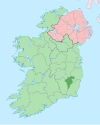Clonmore, County Carlow: Difference between revisions
JJMC89 bot (talk | contribs) Migrate {{Infobox settlement}} coordinates parameters to {{Coord}}, see Wikipedia:Coordinates in infoboxes |
Rescuing 3 sources and tagging 0 as dead. #IABot (v1.5beta) |
||
| Line 40: | Line 40: | ||
==History== |
==History== |
||
Clonmore was named after [[St Mogue]] who, around the year [[530 in Ireland|530]], established a religious community and built a [[monastery]] at the location.The significant feature of the village is Clonmore Castle, this castle was not mentioned until the 14th century, but the shape of the trefoil window in the south wall shows that it was built probably towards the end of the 13th century. The castle is nearly square in plan with rectangular towers at the southern sides of the courtyard. Clonmore was captured in 1516 by the Earl of Kildare and in 1598 by the Earl of Ormond. It changed hands several times and was finally taken by [[Oliver Cromwell]]'s forces under Colonel Hewson in 1650. Today much of the castle has been removed for construction of local amenities such as the neighbouring hall and former schoolhouse <ref>[http://www.carlowtourism.com/mclonmore.html clonmore<!-- Bot generated title -->]</ref><ref>[http://www.hgstump.de/clonmorecastle.htm]</ref> |
Clonmore was named after [[St Mogue]] who, around the year [[530 in Ireland|530]], established a religious community and built a [[monastery]] at the location.The significant feature of the village is Clonmore Castle, this castle was not mentioned until the 14th century, but the shape of the trefoil window in the south wall shows that it was built probably towards the end of the 13th century. The castle is nearly square in plan with rectangular towers at the southern sides of the courtyard. Clonmore was captured in 1516 by the Earl of Kildare and in 1598 by the Earl of Ormond. It changed hands several times and was finally taken by [[Oliver Cromwell]]'s forces under Colonel Hewson in 1650. Today much of the castle has been removed for construction of local amenities such as the neighbouring hall and former schoolhouse <ref>[http://www.carlowtourism.com/mclonmore.html clonmore<!-- Bot generated title -->] {{webarchive|url=https://web.archive.org/web/20071117040249/http://www.carlowtourism.com/mclonmore.html |date=2007-11-17 }}</ref><ref>[http://www.hgstump.de/clonmorecastle.htm]</ref> |
||
==See also== |
==See also== |
||
| Line 49: | Line 49: | ||
{{Commonscat|Clonmore, County Carlow}} |
{{Commonscat|Clonmore, County Carlow}} |
||
==External links== |
==External links== |
||
* [http://www.carlowtourism.com/mclonmore.html Clonmore] |
* [https://web.archive.org/web/20071117040249/http://www.carlowtourism.com/mclonmore.html Clonmore] |
||
* [ |
* [https://web.archive.org/web/20110204123656/http://deerytrailers.ie/ Deery Trailers] |
||
{{County Carlow}} |
{{County Carlow}} |
||
Revision as of 16:39, 9 August 2017
Clonmore
Cluain Mhór | |
|---|---|
Town | |
| Coordinates: 52°49′29″N 6°34′08″W / 52.8247°N 6.5689°W | |
| Country | Ireland |
| Province | Leinster |
| County | County Carlow |
| Elevation | 173 m (568 ft) |
| Population (2002) | |
| • Rural | 461 |
| Time zone | UTC+0 (WET) |
| • Summer (DST) | UTC-1 (IST (WEST)) |
| Irish Grid Reference | S965757 |
Clonmore (Irish: Cluain Mhór, meaning 'Mogue's large meadow') is a village in County Carlow, Ireland. It is located 3½ miles south of Hacketstown and 9 miles east of Tullow in the north-east corner of County Carlow.
History
Clonmore was named after St Mogue who, around the year 530, established a religious community and built a monastery at the location.The significant feature of the village is Clonmore Castle, this castle was not mentioned until the 14th century, but the shape of the trefoil window in the south wall shows that it was built probably towards the end of the 13th century. The castle is nearly square in plan with rectangular towers at the southern sides of the courtyard. Clonmore was captured in 1516 by the Earl of Kildare and in 1598 by the Earl of Ormond. It changed hands several times and was finally taken by Oliver Cromwell's forces under Colonel Hewson in 1650. Today much of the castle has been removed for construction of local amenities such as the neighbouring hall and former schoolhouse [1][2]
See also
References
Article: The Riches of Clonmore by Eddie McDonald


